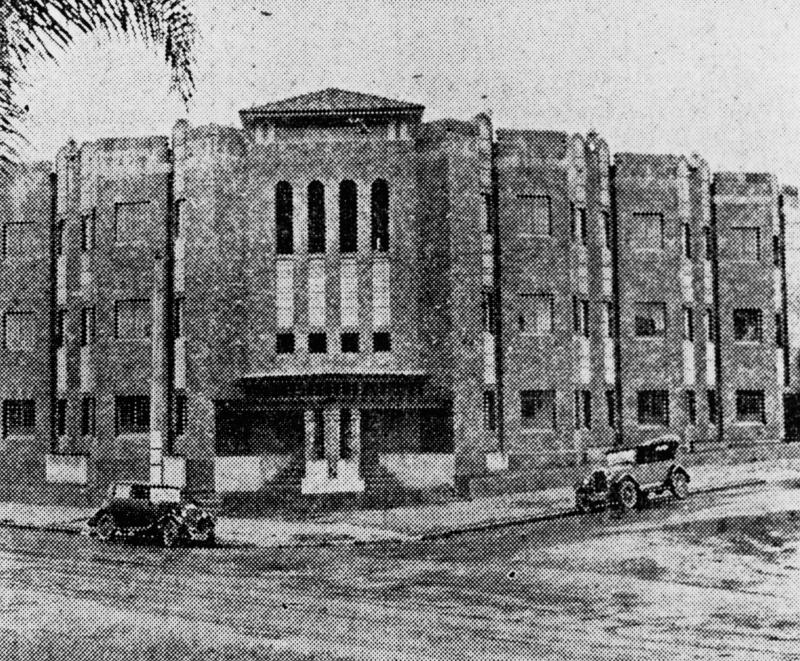Addresses
Type of place
Flat building
Period
Interwar 1919-1939
Style
Art Deco
Addresses
Type of place
Flat building
Period
Interwar 1919-1939
Style
Art Deco
‘Coronet Flats’ was designed by the owner, Max Strickland, a Melbourne businessman, proprietor of the Stucoid Modelling Company. The flats were built on the site of Richard Gailey Junior’s home ‘Burnage’, burnt down in January 1932. The three-storey brick building of nine flats was designed to meet the demand by the growing middle-class rental market for ‘up-to-date, well-serviced flats’ similar to those in the southern cities. ‘Coronet Flats’ was promoted in the newspapers of the day for its private entrances, garages, and labour-saving facilities and conveniences. Features of the building were designed to maximise its corner site with angled bays on either side of the central pergola entrance for ventilation and views of New Farm Park. Distinctive features include the accordian pattern at parapet level, faceted facade to maximise breezes and views of the park from each flat, the central pergola entry with leadlight feature windows and decorative masonry panels below the windows.
Also known as
Coronet Court
Lot plan
Key dates
Local Heritage Place Since —
Date of Citation —
Construction
Walls: Face brickPeople/associations
Max Stricland (Architect);T. Larking (Builder)
Criterion for listing
(A) Historical; (B) Rarity; (D) Representative; (E) AestheticInteractive mapping
Also known as
Coronet Court
Lot plan
Key dates
Local Heritage Place Since —
Date of Citation —
Construction
Walls: Face brickPeople/associations
Max Stricland (Architect);T. Larking (Builder)
Criterion for listing
(A) Historical; (B) Rarity; (D) Representative; (E) AestheticInteractive mapping
History
Family history records that “the decorative stained glass windows” were “designed by Strickland in conjunction the artist Charles Lancaster”.
In 1939 the property was purchased by Thomas Maloney, who bought the property for his daughter Eileen O’Connor. Both names appear on the title which records Thomas Maloney’s death in 1948. According to family history, in the late 1950s and early 1960s Eileen O’Connor and her daughter were “struggling to maintain the building after a long period of rent control”. In contrast to the new suburbs with new stand- alone houses, flats became increasingly associated with “poor quality budget accommodation” and “shabbiness”. The O’Connor women “knew that this did not reflect the slightly worn grandeur of their beloved Coronet” and they adopted the more regal nomenclature of nearby apartment buildings, Coronet Court. This name, reflecting wider social and economic historical trends, has been retained on the restored pergola and the entrance.1
Statement of significance
Relevant assessment criteria
This is a place of local heritage significance and meets one or more of the local heritage criteria under the Heritage planning scheme policy of the Brisbane City Plan 2014. It is significant because:
Supporting images

Queensland Newspapers Pty Ltd,
‘Coronet Flats in New Farm, Brisbane, 1933',
John Oxley Library, State Library of Queensland
References
-
O’Connor, Tamsin “Submission regarding Amendments to the Brisbane City Plan with particular reference to the Heritage Register Scheme Policy”. Received 20 Feb 2012
-
Brisbane City Council Properties on the Web
-
Brisbane City Council 1938 and 1946 aerial photographs
-
Brisbane City Council, Sewerage Maps, Detail Plan No 169, 18 June 1925
-
Brisbane City Council, Surveyor’s Notebook, 30 April 1925
-
Brisbane City Council, New Farm and Teneriffe Hill Heritage and Character Study, Oct 1995, pg 74
-
Certificates of Title, Department of Environment and Resource Management
-
Dept of Environment and Resource Management, ‘Julius Street Flats’, Queensland Heritage Register entry
-
Bennett, H, ‘New Farm from quality street to mixed assortment’, Brisbane Houses, Gardens, Suburbs and Congregations, Papers No 22 Brisbane History Group, 2010 pg 144-145
-
Bennett, H. and J. Schiavo, ‘New Farm Timeline’, Brisbane History Group, 1999
-
Bennett, H, ‘New Farm from quality street to mixed assortment’, Brisbane Houses, Gardens, Suburbs and Congregations, Papers No 22 Brisbane History Group, 2010 pg 144-145
-
Richards, S., Coronet Court, National Trust of Queensland citation, 1997
-
Brisbane Courier, 19 Jan 1932, pg 16
-
Brisbane Courier, 22 Feb 1932, pg 9
-
Brisbane Courier, 21 April 1933, pg 5
-
Courier Mail, 17 Nov 1933, pg 5
-
Courier Mail, 20 Jan, 1934, pg 5
-
Brisbane News, 29 November-5 December 1995, pg 4
-
Apperly, Richard, Robert Irving and Peter Reynolds. A Pictorial Guide to Identifying Australian Architecture: Styles and Terms from 1788 to the Present. North Ryde: Angus & Robertson, 1989
-
Kennedy, Michael Owen. Domestic Architecture in Queensland Between the Wars. Unpub Thesis. Master of Built Environment. 1989
Citation prepared by — Brisbane City Council (page revised June 2022)